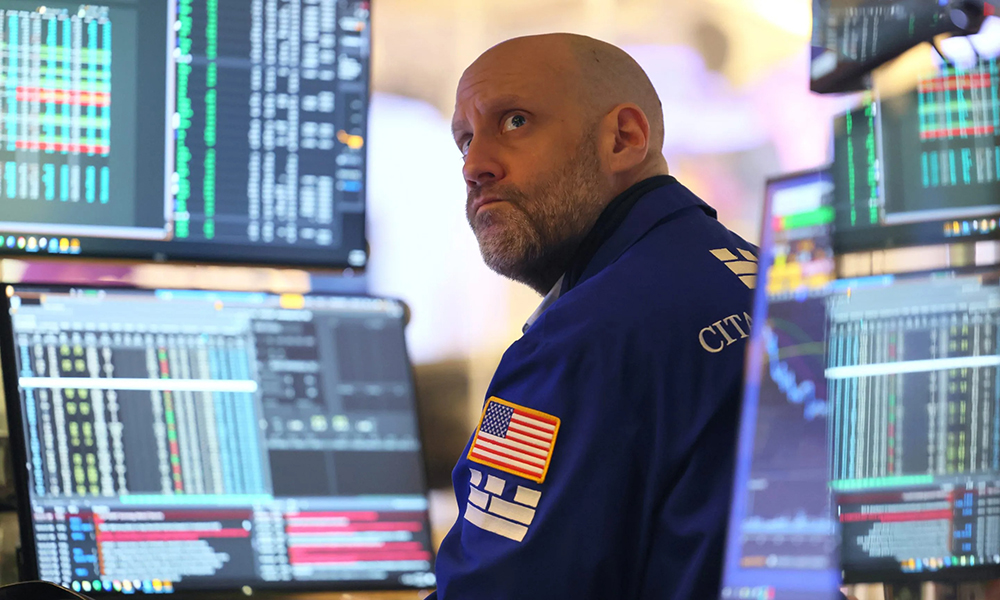研究发现,美国银行的未实现损失高达1.7万亿美元,这可能是一枚“定时炸弹”

硅谷银行(Silicon Valley Bank)和签名银行(Signature Bank)在今年3月早些时候突然倒闭之后,再加上上周瑞士信贷(Credit Suisse)不合时宜地陷入困境,监管部门和商界领袖都在努力向消费者保证银行是安全的。美国联邦存款保险公司(Federal Deposit Insurance Corp.)、美联储(Federal Reserve)和美国财政部已经联手宣布,为硅谷银行和签名银行无保险和有保险的所有储户兜底,因此目前危机在整个金融系统“蔓延”的可能性较小。
例如,经过美国史上规模第二大和第三大银行倒闭案后,美国财政部的部长珍妮特·耶伦在上周对参议院金融委员会(Senate Finance Committee)的立法者表示,美国人可以“相信”存款的安全。据路透社(Reuters)报道,花旗集团(Citigroup)的首席执行官简·弗雷泽于3月22日告诉华盛顿特区经济俱乐部(Economic Club of Washington D.C.),银行系统“依旧稳健”,大型银行和区域银行“资本充足”,而且“没有发生信用危机”。
硅谷银行倒闭后不久,瑞士信贷陷入困境。当时,分析师认为瑞士信贷丑闻缠身,因为诸多备受关注的问题,比如2021年的Archegos对冲基金爆仓等,亏损已经高达数十亿美元,而且客户和储户对瑞士信贷失去了信心。他们表示,硅谷银行在风险管理方面犯下了致命错误,这些错误本来能够轻松避免,但这并不代表整个金融系统的健康出现了问题。
然而,利率上涨不仅导致硅谷银行大量无保险的储户发生挤兑,还使硅谷银行产生了大量未实现损失。纽约大学(New York University)的研究人员在3月13日发表的一篇报告中指出,存在未实现损失的不止硅谷银行,2022年年底,美国银行的未实现损失达到1.7万亿美元。菲利普·施纳贝尔教授和亚力克西·萨沃夫教授以及宾夕法尼亚大学(University of Pennsylvania)的伊塔马尔·德雷克斯勒解释称,这些未实现损失几乎与这些银行的2.1万亿美元股权总额相当。
持续加息导致美国国债和抵押贷款担保证券贬值,而这些资产在许多银行占巨大比重。在3月13日发布的另外一份报告中,多位高校研究人员发现,仅过去一年,美国银行的资产就贬值了10%。
此外,报告显示,在美国银行17万亿美元的存款中,目前接近7万亿美元没有美国联邦存款保险公司的保险。研究的作者包括南加州大学(University of Southern California)的姜雪薇(音译)、美国西北大学(Northwestern University)的格雷戈尔·马特沃斯、哥伦比亚大学(Columbia University)的托马斯·皮斯科尔斯基和斯坦福大学(Stanford University)的阿米特·塞鲁。他们解释称,如果在最近银行业的动荡之后,无保险的储户决定取走资金,可能就会有数千亿美元的存款面临危险。
他们写道:“即使无保险存款挤兑迫使银行小规模低价出售[资产],将有更多银行面临风险。总之,这些计算结果表明,最近银行资产贬值大幅加剧了美国银行系统的脆弱性。”
危在旦夕
根据银行的会计方法,银行持有的资产按购买价值记入账目,而不是当前的市场价值,因此银行的资产负债表中不会体现未实现损失。科罗拉多州立大学(Colorado State University)的经济学教授、区域经济发展研究所(Regional Economic Development Institute)的联席所长斯蒂芬·韦勒指出,当银行面临挤兑,大量储户纷纷提款时,银行不得不出售资产,这时这些损失就会变成已实现损失。这就是硅谷银行的遭遇。储户大量要求取款,迫使其不得不出售抵押贷款担保证券,税前损失达到24亿美元。
韦勒在3月23日对《财富》杂志表示:“只要储户不在同一天蜂拥取走存款,那就万事大吉。”
以尼古劳斯·帕尼吉佐格鲁为首的摩根大通(JPMorgan)分析师在上周称,问题是在硅谷银行破产后,“最脆弱的”美国银行已经被取走了1万亿美元存款。
韦勒警告:“因此银行不得不面对这些未实现损失的可能性提高,”这可能引发更多银行挤兑。
面对美国银行业存在的这个潜在问题,有多位政界人士,包括马萨诸塞州参议员伊丽莎白·沃伦和加州众议员罗·康纳等,都认为美联储应该为所有银行的各类储户兜底,以免发生更多银行挤兑。据路透社报道,3月22日,美国财政部的部长珍妮特·耶伦告诉参议院拨款小组委员会,她并未考虑为美国所有银行储户提供“全面保险”,除非真得出现“系统性风险”。上周,要求美联储兜底的呼声日益强烈。
就连亿万富翁对冲基金经理比尔·阿克曼也在上周表示,美国联邦存款保险公司应该“止血”,并且“明确保证为所有存款提供担保”。
潘兴广场资本管理公司(Pershing Square Capital Management)的创始人阿克曼在3月22日发推文称:“我们的立场已经从含蓄地支持储户,变成了[耶伦部长]今天明确提出的不考虑任何担保。”他说:“如果在短期内不发生存款外流,这才会让我意外。”(财富中文网)
译者:刘进龙
审校:汪皓
硅谷银行(Silicon Valley Bank)和签名银行(Signature Bank)在今年3月早些时候突然倒闭之后,再加上上周瑞士信贷(Credit Suisse)不合时宜地陷入困境,监管部门和商界领袖都在努力向消费者保证银行是安全的。美国联邦存款保险公司(Federal Deposit Insurance Corp.)、美联储(Federal Reserve)和美国财政部已经联手宣布,为硅谷银行和签名银行无保险和有保险的所有储户兜底,因此目前危机在整个金融系统“蔓延”的可能性较小。
例如,经过美国史上规模第二大和第三大银行倒闭案后,美国财政部的部长珍妮特·耶伦在上周对参议院金融委员会(Senate Finance Committee)的立法者表示,美国人可以“相信”存款的安全。据路透社(Reuters)报道,花旗集团(Citigroup)的首席执行官简·弗雷泽于3月22日告诉华盛顿特区经济俱乐部(Economic Club of Washington D.C.),银行系统“依旧稳健”,大型银行和区域银行“资本充足”,而且“没有发生信用危机”。
硅谷银行倒闭后不久,瑞士信贷陷入困境。当时,分析师认为瑞士信贷丑闻缠身,因为诸多备受关注的问题,比如2021年的Archegos对冲基金爆仓等,亏损已经高达数十亿美元,而且客户和储户对瑞士信贷失去了信心。他们表示,硅谷银行在风险管理方面犯下了致命错误,这些错误本来能够轻松避免,但这并不代表整个金融系统的健康出现了问题。
然而,利率上涨不仅导致硅谷银行大量无保险的储户发生挤兑,还使硅谷银行产生了大量未实现损失。纽约大学(New York University)的研究人员在3月13日发表的一篇报告中指出,存在未实现损失的不止硅谷银行,2022年年底,美国银行的未实现损失达到1.7万亿美元。菲利普·施纳贝尔教授和亚力克西·萨沃夫教授以及宾夕法尼亚大学(University of Pennsylvania)的伊塔马尔·德雷克斯勒解释称,这些未实现损失几乎与这些银行的2.1万亿美元股权总额相当。
持续加息导致美国国债和抵押贷款担保证券贬值,而这些资产在许多银行占巨大比重。在3月13日发布的另外一份报告中,多位高校研究人员发现,仅过去一年,美国银行的资产就贬值了10%。
此外,报告显示,在美国银行17万亿美元的存款中,目前接近7万亿美元没有美国联邦存款保险公司的保险。研究的作者包括南加州大学(University of Southern California)的姜雪薇(音译)、美国西北大学(Northwestern University)的格雷戈尔·马特沃斯、哥伦比亚大学(Columbia University)的托马斯·皮斯科尔斯基和斯坦福大学(Stanford University)的阿米特·塞鲁。他们解释称,如果在最近银行业的动荡之后,无保险的储户决定取走资金,可能就会有数千亿美元的存款面临危险。
他们写道:“即使无保险存款挤兑迫使银行小规模低价出售[资产],将有更多银行面临风险。总之,这些计算结果表明,最近银行资产贬值大幅加剧了美国银行系统的脆弱性。”
危在旦夕
根据银行的会计方法,银行持有的资产按购买价值记入账目,而不是当前的市场价值,因此银行的资产负债表中不会体现未实现损失。科罗拉多州立大学(Colorado State University)的经济学教授、区域经济发展研究所(Regional Economic Development Institute)的联席所长斯蒂芬·韦勒指出,当银行面临挤兑,大量储户纷纷提款时,银行不得不出售资产,这时这些损失就会变成已实现损失。这就是硅谷银行的遭遇。储户大量要求取款,迫使其不得不出售抵押贷款担保证券,税前损失达到24亿美元。
韦勒在3月23日对《财富》杂志表示:“只要储户不在同一天蜂拥取走存款,那就万事大吉。”
以尼古劳斯·帕尼吉佐格鲁为首的摩根大通(JPMorgan)分析师在上周称,问题是在硅谷银行破产后,“最脆弱的”美国银行已经被取走了1万亿美元存款。
韦勒警告:“因此银行不得不面对这些未实现损失的可能性提高,”这可能引发更多银行挤兑。
面对美国银行业存在的这个潜在问题,有多位政界人士,包括马萨诸塞州参议员伊丽莎白·沃伦和加州众议员罗·康纳等,都认为美联储应该为所有银行的各类储户兜底,以免发生更多银行挤兑。据路透社报道,3月22日,美国财政部的部长珍妮特·耶伦告诉参议院拨款小组委员会,她并未考虑为美国所有银行储户提供“全面保险”,除非真得出现“系统性风险”。上周,要求美联储兜底的呼声日益强烈。
就连亿万富翁对冲基金经理比尔·阿克曼也在上周表示,美国联邦存款保险公司应该“止血”,并且“明确保证为所有存款提供担保”。
潘兴广场资本管理公司(Pershing Square Capital Management)的创始人阿克曼在3月22日发推文称:“我们的立场已经从含蓄地支持储户,变成了[耶伦部长]今天明确提出的不考虑任何担保。”他说:“如果在短期内不发生存款外流,这才会让我意外。”(财富中文网)
译者:刘进龙
审校:汪皓
After the rapid collapse of Silicon Valley Bank and Signature Bank earlier March, along with Credit Suisse’s untimely demise last week, regulators and business leaders have made it a point to publicly assure consumers that banks are safe. The potential for “contagion” throughout the financial system is now slim after the Federal Deposit Insurance Corp. (FDIC), Federal Reserve, and Treasury came together to backstop all depositors, both uninsured and insured, at SVB and Signature, they say.
Treasury Secretary Janet Yellen, for example, told lawmakers on the Senate Finance Committee last week after the second- and third-largest bank failures in history that Americans “can feel confident” about the safety of their deposits. And Citigroup CEO Jane Fraser told the Economic Club of Washington D.C. on March 22 that the banking system is “sound,” and both large and regional banks are “well-capitalized,” adding “this is not a credit crisis,” Reuters reported.
When Credit Suisse went under shortly after Silicon Valley Bank, analysts argued that it was a scandal-plagued institution that had racked up billions in losses from high profile issues—including the Archegos hedge fund implosion of 2021—and its clients and depositors merely lost confidence. And they note that Silicon Valley Bank made fatal, and easily avoidable, errors in risk management that aren’t indicative of the health of the overall financial system.
But SVB also suffered from heavy unrealized losses caused by rising interest rates that helped to trigger a bank run from its large base of uninsured depositors. And a new paper by researchers at New York University on March 13 found that they aren’t the only ones with these issues—U.S. banks had unrealized losses of $1.7 trillion at the end of 2022. The losses were nearly equal to banks’ total equity of $2.1 trillion, professors Philip Schnabel and Alexi Savov and the University of Pennsylvania’s Itamar Drechsler explained.
Rising interest rates have slashed the value of the U.S. Treasuries and mortgage-backed securities that make up a large portion of many banks’ assets. In another paper, also from March 13, university researchers found that U.S. banks’ assets have lost 10% of their value over the past year alone.
Additionally, of the $17 trillion in total U.S. bank deposits, nearly $7 trillion are currently not insured by the FDIC, according to that paper. The authors of the study—including University of Southern California’s Erica Xuewei Jiang, Northwestern University’s Gregor Matvos, Columbia University’s Tomasz Piskorski, and Stanford University’s Amit Seru—explained that if half of these uninsured depositors decide to withdraw their funds after the recent bank instability, it could put hundreds of billions of dollars of deposits in jeopardy.
“If uninsured deposit withdrawals cause even small fire sales [of assets], substantially more banks are at risk,” they wrote. “Overall, these calculations suggest that recent declines in bank asset values very significantly increased the fragility of the U.S. banking system.”
No fire without a spark
Unrealized losses aren’t reflected on banks’ balance sheets due to an accounting practice where assets are held on banks’ books at the value at which they are bought, instead of their current market value. And Stephan Weiler, an economics professor at Colorado State University and co-director of the Regional Economic Development Institute, explained that these losses will only be realized by banks if they are forced to sell their holdings amid a bank run where depositors withdraw their funds en masse. That’s what happened with SVB, depositors asked for the money back in droves, forcing the bank to sell its holdings of mortgage-backed securities at a $2.4 billion pre-tax loss.
“As long as people aren’t all coming in at the same time and demanding that their deposits back, you’re okay,” Weiler told Fortune on March 23.
The problem, JPMorgan’s analysts led by Nikolaos Panigirtzoglou noted last week, is that $1 trillion in deposits were pulled from the “most vulnerable” U.S. banks after SVB’s collapse.
“So the chances of facing those unrealized losses are going up,” Weiler warned, and that could lead to more bank runs.
As a result of this potential problem for U.S. banks, multiple politicians, including Massachusetts Sen. Elizabeth Warren and California Rep. Ro Khanna, have argued the Fed should backstop every type of depositor at all banks to prevent further bank runs from the public. And those calls intensified this week after Treasury Secretary Janet Yellen told the Senate Appropriations subcommittee on March 22 that she is not considering “blanket insurance” for all U.S. bank deposits, unless “systemic risk” becomes an issue, Reuters reported.
Even the billionaire hedge fund manager Bill Ackman said last week that the FDIC “stop the bleeding” and “explicitly guarantee all deposits now.”
“We have gone from implicit support for depositors to [Secretary Yellen’s] explicit statement today that no guarantee is being considered,” Ackman, who founded Pershing Square Capital Management tweeted on March 22, adding that he “would be surprised if deposit outflows don’t accelerate, effective immediately.”













